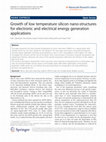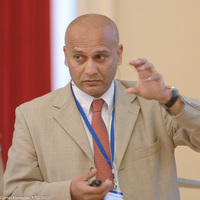Papers by Krishna Nama Manjunatha
Progress in Solid State Chemistry
IEEE Journal of Photovoltaics
Core–shell silicon–silicon oxide nanowires are synthesized at low temperatures using inorganic an... more Core–shell silicon–silicon oxide nanowires are synthesized at low temperatures using inorganic and organic compounds of a tin as a catalyst. In situ simultaneous one-dimensional growth of pristine silicon nanowires (SiNWs) using alloy catalyst is reported here. Such a development process generates a high-quality SiNW that is not determined by other atomic species in the plasma. A possible growth model is discussed to understand the synchronized precipitation of a SiNW core and an oxide shell. Nanowires grown here eliminate the additional fabrication steps to deposit anticipated oxide shell that is achieved by precipitation from the same catalyst that precipitates core nanowires.

Effect of plasma treatment on transparent conductive oxides (TCOs) including indium-doped tin oxi... more Effect of plasma treatment on transparent conductive oxides (TCOs) including indium-doped tin oxide (ITO), fluorine-doped tin oxide (FTO) and aluminium-doped zinc oxide (AZO) are discussed. Stability of electrical and optical properties of TCOs, when exposed to plasma species generated from gases such as hydrogen and silane, are studied extensively. ITO and FTO thin films are unstable and reduce to their counterparts such as Indium and Tin when subjected to plasma. On the other hand, AZO is not only stable but also shows superior electrical and optical properties. The stability of AZO makes it suitable for electronic applications, such as solar cells and transistors that are fabricated under plasma environment. TCOs exposed to plasma with different fabrication parameters are used in the fabrication of silicon nanowire solar cells. The performance of solar cells, which is mired by the plasma, fabricated on ITO and FTO is discussed with respect to plasma exposure parameters while showing the advantages of using chemically stable AZO as an ideal TCO for solar cells. Additionally, in-situ diagnostic tool (optical emission spectroscopy) is used to monitor the deposition process and damage caused to TCOs.

Flexible Semi-Transparent electronic memory would be useful in coming years for integrated flexib... more Flexible Semi-Transparent electronic memory would be useful in coming years for integrated flexible transparent electronic devices. However, attaining such flexibility and semi-transparency leads to the boundaries in material composition. Thus, impeding processing speed and device performance. In this work, we present the use of inorganic stable selenium nanoparticles (Se-NPs) as a storage element and hydrogenated amorphous carbon (a-C:H) as an insulating layer in two terminal non-volatile physically flexible and semi-transparent capacitive memory devices (2T-NMDs). Furthermore, a-C:H films can be deposited at very low temperature (<40° C) on a variety of substrates (including many kinds of plastic substrates) by an industrial technique called Plasma Enhanced Chemical Vapour Deposition (PECVD) which is available in many existing fabrication labs. Self-assembled Se-NPs has several unique features including deposition at room temperature by simple vacuum thermal evaporation process without the need for further optimisation. This facilitates the fabrication of memory on a flexible substrate. Moreover, the memory behaviour of the Se-NPs was found to be more distinct than those of the semiconductor and metal nanostructures due to higher work function compared to the commonly used semiconductor and metal species. The memory behaviour was observed from the hysteresis of current-voltage (I–V) measurements while the two distinguishable electrical conductivity states (“0” and “1”) were studied by current-time (I–t) measurements.
We report the growth of self-doped silicon nanowires (SiNWs), using gallium and bismuth catalysts... more We report the growth of self-doped silicon nanowires (SiNWs), using gallium and bismuth catalysts, by employing a vapour-liquid-solid method. This enables the formation of both p- and n-doped nanowires without the use of expensive and toxic gases that are conventionally used and opens a new route to a simplified and cost effective process for doping SiNWs. The chosen catalysts have the lowest eutectic temperature available for the growth of silicon nanowires. The growth of self-doped SiNWs, for the fabrication of photovoltaic cells, has been demonstrated for the first time in this study.

Diamond-like carbon (DLC) film is a mixture of various allotropes of carbon; predominantly it is ... more Diamond-like carbon (DLC) film is a mixture of various allotropes of carbon; predominantly it is comprised of sp3 and sp2, with hydrogen stabilising the dangling bonds. The film is a metastable form of amorphous carbon, possessing a range of attractive chemical, mechanical, tribological, optical and electrical properties. The electrical and optical properties of the film are mainly determined by the sp3/sp2 ratio and the amount of hydrogen content in the DLC. A number of methods have been employed previously to understand the sp3/sp2 ratio and the amount of hydrogen in DLC thin film; for example, Raman analysis of the sp3/sp2 ratio and Rutherford backscattering and infrared spectroscopy for the estimation of the hydrogen content. The information regarding the sp3/sp2 ratio and the amount of hydrogen is key to the fabrication of reliable electronic devices. The amount of hydrogen present in the thin films can be estimated according to infrared absorption. Thin films are generally deposited onto substrate; this study investigates the suitability of various substrates for a Fourier transform infrared (FTIR) analysis of DLC.
The transmittance and absorbance data of nickel oxide films are crucial in determining it's optic... more The transmittance and absorbance data of nickel oxide films are crucial in determining it's optical properties. Selection of substrate is important for a greater understanding of optical constants and properties of a material. In view of this Nickel oxide films were deposited on Quartz substrates and it's properties are compared with Nickel oxide films deposited on glass. We show the difference in optical constants measured for Nickel oxide thin film deposited on glass and quartz substrates.
Nickel oxide has been investigated for several potential applications, namely, ultraviolet detect... more Nickel oxide has been investigated for several potential applications, namely, ultraviolet detectors, electro chromic devices, displays, diodes for light emitting, transparent conductive electrode, and optoelectronic devices. These applications require an in depth analysis of nickel oxide prior to its exploration in aforementioned devices. Optical properties of materials were investigated by depositing thin film of nickel oxide on different substrates in order to understand if the choice of substrate can have effect on deducing various optical parameters and can lead to wrong conclusions. In view of this, we have investigated optical properties of nickel oxide deposited on different substrates (glass, transparent plastic, sapphire, potassium bromide, and calcium fluoride).

This paper represents the lowest growth temperature for silicon nano-wires (SiNWs) via a vapour-l... more This paper represents the lowest growth temperature for silicon nano-wires (SiNWs) via a vapour-liquid-solid method, which has ever been reported in the literature. The nano-wires were grown using plasma-enhanced chemical vapour deposition technique at temperatures as low as 150°C using gallium as the catalyst. This study investigates the structure and the size of the grown silicon nano-structure as functions of growth temperature and catalyst layer thickness. Moreover, the choice of the growth temperature determines the thickness of the catalyst layer to be used. The electrical and optical characteristics of the nano-wires were tested by incorporating them in photovoltaic solar cells, two terminal bistable memory devices and Schottky diode. With further optimisation of the growth parameters, SiNWs, grown by our method, have promising future for incorporation into high performance electronic and optical devices.







Uploads
Papers by Krishna Nama Manjunatha